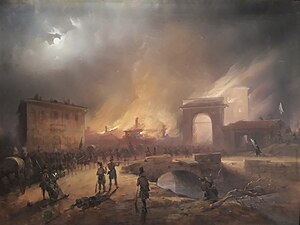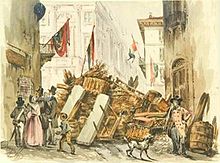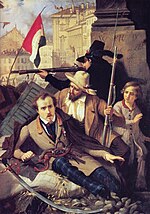You can help expand this article with text translated from the corresponding article in French. (November 2021) Click for important translation instructions.
|
| Five Days of Milan | |||||||
|---|---|---|---|---|---|---|---|
| Part of the First Italian War of Independence | |||||||
 The Five Days of Milan by Carlo Bossoli | |||||||
| |||||||
| Belligerents | |||||||
|
|
| ||||||
| Commanders and leaders | |||||||
|
Carlo Cattaneo Gabrio Casati Luciano Manara |
Joseph Radetzky Ludwig von Wohlgemuth | ||||||
| Strength | |||||||
|
1,700 barricades armed with 600–650 firearms along with stones, bottles, clubs, pikes and swords | 12,000 garrison | ||||||
| Casualties and losses | |||||||
|
409–424 killed including 43 women and children 600+ wounded |
181 killed including 5 officers 235 wounded including 4 officers 150–180 captured | ||||||
| First Italian War of Independence | |
|---|---|
Provisional Government of Milan
| |||||||||
|---|---|---|---|---|---|---|---|---|---|
| 1848–1848 | |||||||||
| Capital | Milan | ||||||||
| Common languages | Italian, Lombard | ||||||||
| Government | Republic | ||||||||
| President | |||||||||
| Historical era | Revolutions of 1848 | ||||||||
| • Congress of Vienna grants Lombardy–Venetia to the Austrian Empire | 9 June 1815 | ||||||||
| • Insurrection against Habsburg rule | 18 March 1848 | ||||||||
| • Battle of Custoza, thereafter returns to Habsburg rule | 22-27 July 1848 | ||||||||
| • Battle of Solferino wins Lombardy for Italy | 24 June 1859 | ||||||||
| |||||||||
The Five Days of Milan (Italian: Cinque giornate di Milano [ˈtʃiŋkwe dʒorˈnaːte di miˈlaːno]) was an insurrection and a major event in the Revolutionary Year of 1848 that started the First Italian War of Independence. On 18 March, a rebellion arose in the city of Milan which in five days of street fighting drove Marshal Radetzky and his Austrian soldiers from the city.
Background
In 1848, the Milanese launched an anti-Austrian campaign as early as 1 January. On New Year's Day the Milanese started to boycott gambling and tobacco products, which were government monopolies that brought in over 5 million lire a year. The boycott culminated in a bloody street battle on 3 January, when Austrian soldiers, in batches of three, were being insulted and pelted with stones by an angry crowd. The soldiers then gathered together in groups of a dozen and charged the crowd with swords and bayonets, killing five and wounding another 59. Radetzky confined his troops to barracks for five days. The protests were over, but two months later, when news reached Milan of the uprising in Vienna and the fall of Metternich, the Milanese took to the streets again, on 18 March.
Events


Almost simultaneously with the popular uprisings of 1848 in the Kingdom of Lombardy–Venetia, on 18 March of that year, the city of Milan also rose up. This was the first evidence of how effective popular initiative, guided by those in the Risorgimento, was able to influence Charles Albert of Sardinia.
The Austrian garrison at Milan was well equipped and commanded by an experienced general, Joseph Radetzky von Radetz, who despite being over 80 years old, was energetic and rigid. Radetzky had no intention of yielding to the uprising.
However, the whole city fought throughout the streets, raising barricades, firing from windows and roofs, and urging the rural population to join them. The populace was backed by the archbishop and at least 100 priests joined in the fighting against the Austrians. A bust of Pope Pius IX was hoisted onto the barricades. A provisional government of Milan was formed and presided over by the podestà, Gabrio Casati and a council of war under Carlo Cattaneo. The Martinitt (orphanage children) worked as message runners to all parts of the town.
Radetzky saw the difficulty of resisting under siege in the city centre, but while afraid of being attacked by the Piedmontese army and peasants from the countryside, he preferred to withdraw after losing control of the Porta Tosa (now Porta Vittoria) to the rebels. On the evening of 22 March, the Austrians withdrew towards the "Quadrilatero" (the fortified zone bounded by the four cities of Verona, Legnago, Mantua and Peschiera del Garda), 120 km eastwards, taking with them several hostages arrested at the start of the uprising. Meanwhile, the rest of Lombard and Venetic territory was free.
In memory of these days, the official newspaper of the temporary government was called simply Il 22 marzo (22 March), which began publication on 26 March at the Palazzo Marino under the direction of Carlo Tenca. A Monument to the Five Days of Milan by the sculptor Giuseppe Grandi was inaugurated in 1895 at what is now Porta Vittoria.
Almost a century later, in 1943, the uprising of Naples against WWII Nazi occupation was named The Four Days of Naples, in conscious emulation of the earlier Milan event.
See also
- Luisa Battistati
- Carlo Cattaneo
- Enrico Dandolo
- Luciano Manara
- Emilio Morosini
- Guerra regia e guerra di popolo
- Revolutions of 1848 in the Italian states
- Milan Uprising
References
- Grenville, John Ashley Soames (2000). Europe reshaped, 1848–1878. Oxford.
{{cite book}}: CS1 maint: location missing publisher (link) - ^ Stillman, William James (1898). The union of Italy, 1815–1895. Cambridge.
{{cite book}}: CS1 maint: location missing publisher (link) - ^ Ginsborg, Paul (1979). Daniele Manin and the Venetian revolution of 1848–49. Bristol. ISBN 9780521220774.
{{cite book}}: CS1 maint: location missing publisher (link) - Maurice, Charles Edmund (1887). The revolutionary movement of 1848–9 in Italy, Austria Hungary, and Germany. New York.
{{cite book}}: CS1 maint: location missing publisher (link) - American Bibliographical Center (1991). Historical abstracts: Volume 42, Issues 3–4. Santa Barbara.
{{cite book}}: CS1 maint: location missing publisher (link) - ^ Rüstow, Wilhelm (1862). Der italienische Krieg von 1848 und 1849. Zürich.
{{cite book}}: CS1 maint: location missing publisher (link) - ^ Whyte, Arthur James Beresford (1975). The political life and letters of Cavour, 1848–1861. Santa Barbara.
{{cite book}}: CS1 maint: location missing publisher (link) - Svoboda, Johann (1870). Die Zöglinge der Wiener-Neustädter Militär-Akademie. Wien.
{{cite book}}: CS1 maint: location missing publisher (link) - de Marguerittes, Julie (1859). Italy and the War of 1859. Philadelphia.
{{cite book}}: CS1 maint: location missing publisher (link) - ^ Chapman, Tim (2008). The risorgimento: Italy 1815–71. Penrith.
{{cite book}}: CS1 maint: location missing publisher (link) - Stearns, Peter N. (1974). 1848: the revolutionary tide in Europe. New York.
{{cite book}}: CS1 maint: location missing publisher (link) - Whittam, John (1977). Politics of the Italian Army, 1861–1918. London.
{{cite book}}: CS1 maint: location missing publisher (link) - ^ Wilhelm Meyer-Ott, Wilhelm Rüstow (1850). Die Kriegerischen Ereignisse in Italien in den Jahren 1848 und 1849. Zürich.
{{cite book}}: CS1 maint: location missing publisher (link) - Gooch, John (1986). The unification of Italy. London.
{{cite book}}: CS1 maint: location missing publisher (link) - ^ Berkeley, George F.-H. (1940). Italy in the Making January 1st 1848 to November 16th 1848. Cambridge.
{{cite book}}: CS1 maint: location missing publisher (link) - M. Clark, The Italian Risorgimento, Routledge 2013 p. 53.
- Luseroni, Giovanni (2016). Giuseppe Mazzini e i Democratici nel Quarantotto Lombardo. Gangemi Editore spa. p. 130. ISBN 9788849299229.
Bibliography
- Olivari, Stefano and Giulia Brasca (2015). Milan 360°: A metropolis to discover, among art, culture, technology and fashion. OlliService Multimedia. pp. 9–11. ISBN 9788899298050.
In Italian
- (in Italian) Piero Pieri, Storia militare del Risorgimento – volume 1 & 2, Einaudi, Torino, 1962
- (in Italian) Carlo Cattaneo, Dell'insurrezione di Milano nel 1848 e della successiva guerra, e-text Liber liber/Progetto Manuzio
- (in Italian) Antonio Scurati, Una storia romantica, romanzo Bompiani, 2007
- (in Italian) Elena Fontanella, a cura di, Giovani ribelli del '48. Memorie del Risorgimento lombardo , Firenze, Fratelli Alinari, 2011. ISBN 978-88-95849-14-0. Testi di Aldo A. Mola, Giancarlo Lacchin, Roberto Lauro, Maurizio Griffo, Agostino Giovagnoli, Cecilia Dau Novelli, Romano Bracalini, Carlo Cattaneo, Gianni Oliva, Emanuele Bettini, Matteo Sanfilippo, Giuseppe Poletta, Franco Della Peruta, Fulvio Peirone, Gabriella Bonacchi, Anna Maria Isastia, Elena Fontanella, Andrea Vento, Vittorio Nichilo, Giorgio Cosmacini, Roberto Guerri, Lucia Romaniello, Giuseppe Garibaldi, Gian Paolo Caprettini, Gian Mario Benzing, Roberto Cassanelli.
External links
- (in Italian) "Liceo Berchet di Milano" – a more detailed account of the Five Days
- (in Italian) Monument to the "Cinque Giornate di Milano"
- "Milano, Cinque giornate di". Dizionario di Storia (in Italian). Istituto dell'Enciclopedia Italiana. 2010. Retrieved 18 March 2024.
- Revolutions of 1848 in the Italian states
- Military history of Milan
- 1848 in Italy
- 1848 in the Austrian Empire
- Battles involving Austria
- Battles involving Italy
- Battles in 1848
- Battles of the First Italian War of Independence
- Military history of Lombardy
- Revolts of the Italian unification
- March 1848 events
- States and territories established in 1848
- States and territories disestablished in 1848
- 1848 establishments in Italy
- 1848 disestablishments in Italy
- 19th century in Milan
- Rebellions against the Austrian Empire
- Joseph Radetzky von Radetz
